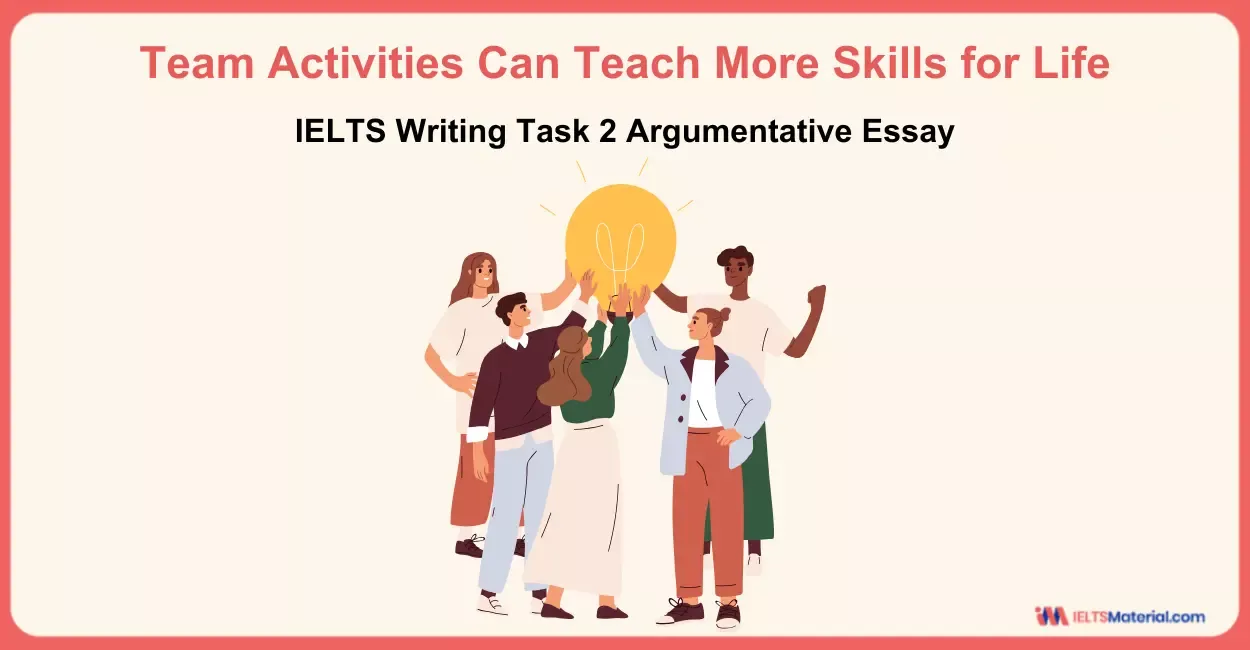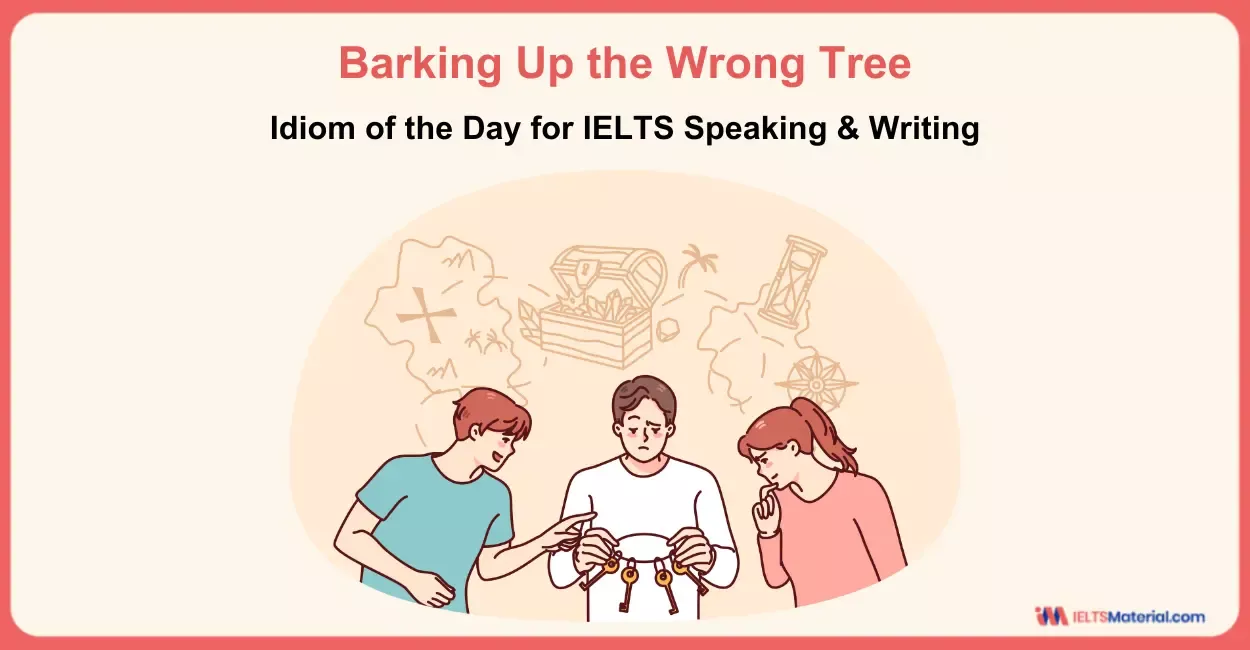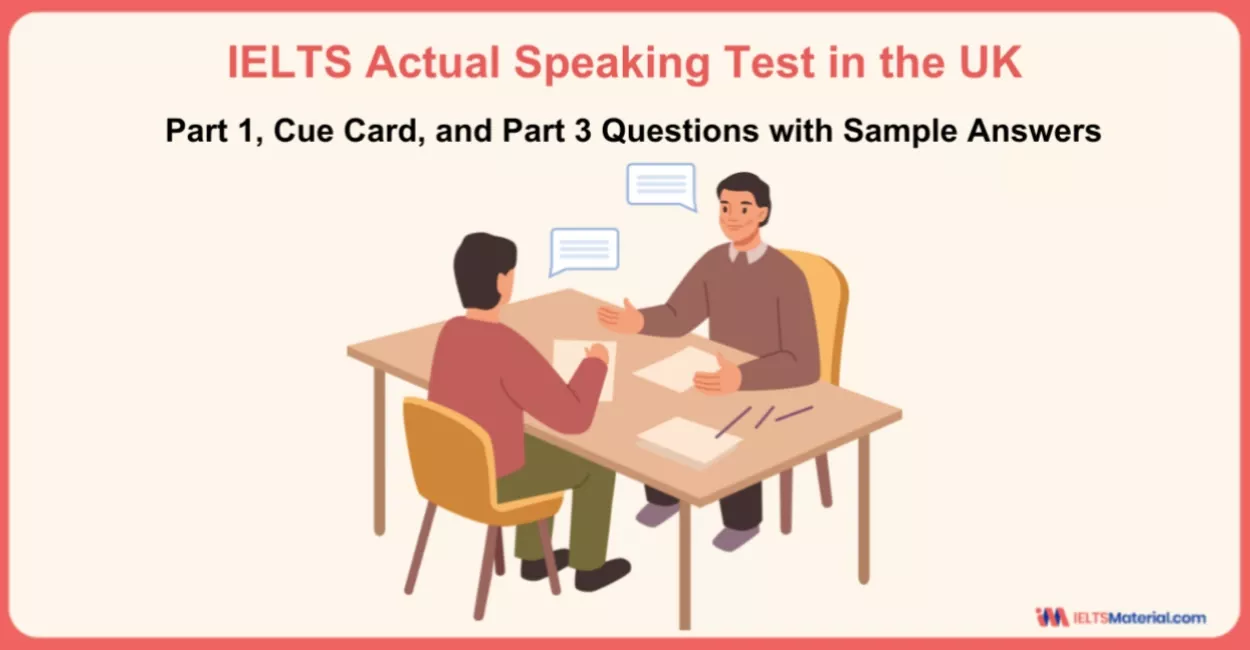IELTS Actual Speaking Test in the UK – Part 1, Cue Card, and Part 3 Questions with Sample Answers
Enhance coherence, vocabulary, and fluency with the IELTS Actual Speaking Test in the UK and learn how to analyze the sample answers of Part 1, Cue Card, and Part 3 Questions to boost your accuracy and confidence for the exam.
Table of Contents

Limited-Time Offer : Access a FREE 10-Day IELTS Study Plan!
Have you wondered why some candidates seem to have no difficulties during the IELTS Actual Speaking Test in the UK? The main reason is related to your level of preparation and the specific strategies you incorporate. Within 11-14 minutes, you have to showcase your fluency, lexical resource, and ability to think quickly during the IELTS Exam. By practicing with mock questions and analyzing the sample answers, you will be able to speak naturally and think critically for an outstanding band score of 8+.
Connect with our band 9 IELTS Trainers to crack your IELTS Speaking in no time! Book a FREE Demo.
How to Analyze the Sample Answers of the IELTS Actual Speaking Test in the UK?
One of the best ways to learn how to become fluent, coherent, and use vocabulary as well as grammar appropriately is by analyzing answers for the IELTS Speaking Test. Examining these responses would help you identify how ideas are structured, where linking words are used, and how vocabulary elevates your answer. Below is a systematic method of analysis that would help you to recognize strengths, eliminate weaknesses, and develop personal speaking styles.
|
Speaking Part |
Topics to Analyze |
Strategy |
|
Part 1 (Introduction & Interview) |
|
|
|
Part 2 (Cue Card) |
|
|
|
Part 3 (Follow-up questions) |
|
|
Want to learn Useful Idioms for IELTS Speaking? Check out the video below!
Part 1 Questions for the IELTS Actual Speaking Test in the UK
As you prepare with the IELTS Actual Speaking Test in the UK, you need to understand each section carefully. For the IELTS Speaking Part 1, you might feel that the questions are quite straightforward, but remember that the examiner uses it to assess your fluency, pronunciation, and ability to speak confidently about everyday topics. Therefore, setting the tone here is crucial for you to achieve a score of band 8+. Let’s look at some of the part 1 questions to prepare for the IELTS Actual Speaking Test in the UK.
1 What is your full name?
Well, I am Meera Shah.
2 Can I see your ID?
Of course! Here it is.
3 Where are you from?
I’m from Nagpur, the third-largest city in the state of Maharashtra. Nagpur is famous for its oranges. This city has a high literacy rate of around 92%and is also one of the most important cities of Vidarbha
4 Do you work or study?
I have recently joined a firm as an intern in which I have to deal with content writing .The senior of mine provides me with a topic and then I have to write around 1500 words on it and also I style it and update the post on the web site.
5 Do you think you are a polite person?
I do think I’m a polite person. I treat other people nicely and patiently, and I do not insult anyone unless they truly deserve it. Also, I properly apologize when I make mistakes and I show my gratitude when other people help me.
6 Do you think people should be polite? Why?
People should always be polite – it shows that they have good manners and it helps them earn others’ respect. Being polite is like having good social skills – it can help one widen their social network, and this can positively influence one’s private and professional life.
7 Who taught you to be polite?
I guess similar to most people, I was raised to be a polite person by my parents. As I spent most of my time around them, they tried to set a good example for me. They also gave me advice and told me moral stories about how being polite and kind to others can help me a lot in real life.
Prepare yourself with the Comprehensive IELTS Speaking Band 8 Preparation Course and ace the IELTS Speaking Test in the UK.
Part 2 Cue Card Questions for the IELTS Actual Speaking Test in the UK
The IELTS Speaking Part 2 would help you to balance fluency with content. Remember that it is just not just speaking but it is also about speaking with clarity and coherence, along with confidence. This part is designed to bring out how well you can express yourself in real situations. Let’s start practicing with the cue card given below!
Describe a painting or work of art.
You should say :
- when you saw this work of art
- where you saw it
- what it looked like
- and explain your impression of it.
Sample Answer for Part 2 Cue Card Questions for the IELTS Actual Speaking Test in the UK
When it comes to arts and anything that is art-related, some of the most recognized artists immediately pop up in our minds such as Picasso, Van Gogh, Mozart, and the like. Honestly speaking, I am not art savvy or hold any particular interest in paintings or musical performance, yet, it would be a shame if I haven’t heard about some of the world’s renowned masterpieces that have gained public attention and recognition like Mona Lisa, The Scream and so on. I was especially impressed by The Starry Night, one of Van Gogh’s most famous artworks and the pride of impressionism of all time.
I first heard about The Starry Night when I was still in primary school. The photo of said painting was printed in our artbook and even though it was poorly depicted due to the quality of the paper, The Starry Night still caught my attention. I, then, came across it once again in a documentary on TV, which was dedicated to presenting a Dutch artist Van Gogh and his career. The Starry Night was created after Van Gogh had mutilated his own ear and been residing in a mental asylum. It is an oil on canvas and currently displayed at the Museum of Modern Art in New York City. The painting was a night sky filled with swirling clouds, eddies of stars and a bright crescent moon. Beneath the hills lies a small town which appears to be tranquil and sluggish. To the very left of the painting is a significantly tall and imposing structure that is hard to interpret and can be explained differently according to any beholder himself. The Starry Night gives me a sense of peacefulness and seclusion at the same time, which can also be why I always feel calm and secure every time I see it. And I hope that I will be able to see this authentic piece of art in person in the near future.
Vocabulary for Part 2 Cue Card Questions for the IELTS Actual Speaking Test in the UK
- Pop up: to appear or happen, especially suddenly or unexpectedly
Eg: I was frustrated with the ads popping up in between the series. - Art savvy: well informed about or experienced in art
Eg: My uncle is art savvy. - Renowned: well-known, famous
Eg: IIM Ahmedabad is a renowned management institute across the country. - Impressionism: a style in painting developed in France in the late 19th century that uses colour to show the effects of light on things and to suggest atmosphere rather than showing exact details
Eg: Pablo Picasso is a painter of impressionism. - Mutilate: to damage somebody’s body very severely
Eg: The prisoners have been tortured and mutilated. - Tranquil: quiet and peaceful
Eg: I was shocked by the tranquility of the place. - Sluggish: moving, reacting or working slower than normal
Eg: After 5 hours of continuous travelling, the driver became sluggish. - Imposing: impressive to look at; making a strong impression
Eg: John has an imposing figure. - Seclusion: the state of being private or of having little contact with other people
Eg: He’s been living in seclusion since he retired from the army.
Part 3 Follow-Up Questions for the IELTS Actual Speaking Test in the UK
The IELTS Speaking Part 3 lasts for about 4-5 minutes which involves discussing broad social issues. The skills tested in this part would include fluency and vocabulary, logically developing arguments, using advanced connectors, and giving examples. Let’s look at the questions for the topic on ‘art and paintings’ so that you can prepare for the IELTS Actual Speaking Test in the UK.
1 Do you think art is important in society?
Yes, art is an essential element in society because it gives insights into one’s culture, history, and emotion. For instance, paintings hold moments that cannot be expressed by just words. Also, the presence of art fosters creativity and critical thinking that is required for innovation.
2 How has the role of art changed since the past?
Historically, art was mostly used for the purpose of storytelling or religious expression. Today, it is also about self- expression, social commentary, and even digital innovation. Digital painting and installation art are two examples of modern art which demonstrate how art is flexible to changing times.
3 Should children learn painting at school?
Yes, I think painting should be taught as a subject in schools because it promotes creativity, imagination, and problem-solving skills. Art can serve as a method to release stress and let out an individual’s emotions positively. These skills are helpful throughout life.
4 Is art appreciated more by the people once it is understood?
Absolutely. When people recognize the meaning, history, or method behind a painting, their level of appreciation increases. Knowing all information about what goes into making an artwork enhances its weightage on the individual and connects it emotionally with him.
5 Do people go to art galleries in your country more often?
It actually depends. There are people who love going to several art galleries to gain knowledge about the culture and history. However, it would be based on a person’s interest which makes them visit such places. There are attempts from schools and tourism operators to increase the numbers, especially among youth.
Vocabulary for Part 3 Follow-Up Questions for the IELTS Actual Speaking Test in the UK
- Foster: To encourage development in something.
Eg: Reading books fosters imagination in the young learner. - Social Commentary: Using creative works to criticize or draw attention to social issues.
Eg: Street art is often a social comment upon political or economic issues. - Insights: Profound realization about something.
Eg: Documentaries give insights on world issues. - Weightage: Importance given to or considered for.
Eg: Practical work is given more weightage than theory in exams. - Aesthetic: Beauty or artistic taste.
Eg: Minimalist aesthetics are very much in trend in modern-day design. - Distinctive: Clearly different or unique.
Eg: Picasso had a very distinctive style of painting.
Enroll into our Free IELTS Webinar and learn more about techniques to improve your speaking answers.
Working on a variety of topics for Part 1, the Part 2 Cue Card, and Part 3 questions in the IELTS Actual Speaking Test in the UK can help improve your thinking and speaking skills. With practice, you will be able to provide logical, coherent, and fluent answers. Therefore, note the areas of improvement so that you can work on them and get a band 9 on the actual exam day.
Also Check:
- 10 Useful IELTS Speaking Tips to Impress the Examiner
- Linking Words for IELTS Speaking Section
- IELTS Speaking Recent Actual Tests with Suggested Answers for IELTS 2025
- 50 IELTS Speaking Part 3 Topics; Questions with Answers
- 75+ Common English Words Used in IELTS Speaking Test
- IELTS Pronunciation Guide 2025
Explore IELTS Speaking

Start Preparing for IELTS: Get Your 10-Day Study Plan Today!
Explore other IELTS Articles

Kasturika Samanta

Prity Mallick


Nehasri Ravishenbagam
Recent Articles
Haniya Yashfeen

Kasturika Samanta

Kasturika Samanta





Post your Comments